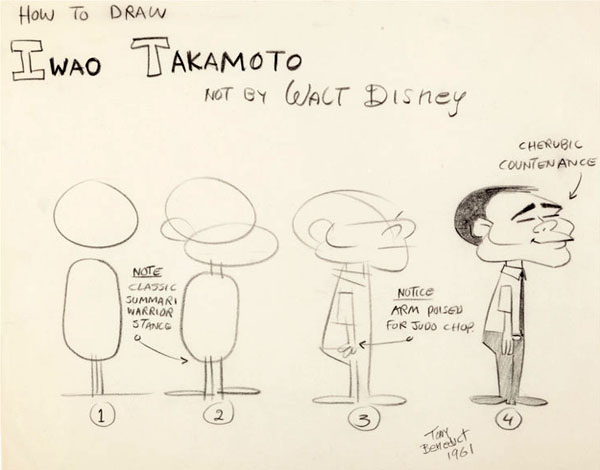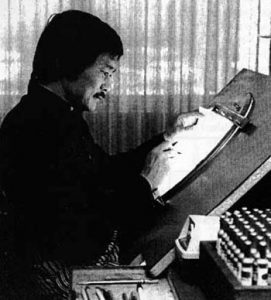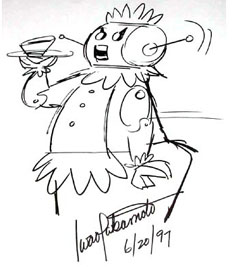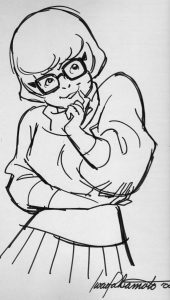
Gag Model Sheet by Tony Benedict in 1962
“When I worked with animators, I was told it was an honored tradition to play pranks on their peers. Since I was always gullible, trusting and took things seriously, I was often the victim of some of these pranks. I certainly never felt honored.”
 In a 1940 Atlantic Monthly magazine article about the Disney Studio, writer Paul Hollister described the Disney Studio as “the only factory on earth where practical jokes are part of the production line”.
In a 1940 Atlantic Monthly magazine article about the Disney Studio, writer Paul Hollister described the Disney Studio as “the only factory on earth where practical jokes are part of the production line”.
“Ward Kimball was the sort of entrepreneur of these types of activities,” remembered animator and production designer Iwao Takamoto but he was not. Most people might be most familiar with Takamoto for his many contributions to the Hanna-Barbera Studios cartoon series including designing the characters in Scooby-Doo, The Jetsons‘ dog Astro, Penelope Pitstop and many other memorable (and not as memorable like The Hillbilly Bears) characters.
However, Takamoto got his start in animation at the Disney Studios when he was barely twenty years old and had just been released from a California internment camp for Japanese-Americans.
In the camp, he met several artists who gave him some art training. One of them, a former art director, recommended that Takamoto look for work at the Disney Studios because he said “it was a liberal place when it came to hiring” meaning that he would not be judged for being Japanese.
“I think that’s what made the Disney Studios so successful,” recalled Takamoto in a 1995 interview. “There was no prejudice about race. Everyone who worked there took people at face value as to whether they could do the job.”
 When he joined the Disney Studios as an assistant animator to Milt Kahl in 1945, Takamoto said that he “had no idea what animation was about. I learned on-the-job, picking up a little from some of the great animators like Milt Kahl, Ward Kimball, and Frank [Thomas] and Ollie [Johnston].”
When he joined the Disney Studios as an assistant animator to Milt Kahl in 1945, Takamoto said that he “had no idea what animation was about. I learned on-the-job, picking up a little from some of the great animators like Milt Kahl, Ward Kimball, and Frank [Thomas] and Ollie [Johnston].”
He was so well liked that, of course, he became a victim of a Disney animator prank.
Just before he turned 21 years old, several animators invited him to join them for a drink to celebrate the upcoming event. They went to a local bar and started downing martinis.
“They asked me to have a martini with them and I told them I didn’t know anything about martinis,” Takamoto said. “I learned that martinis have olives and the olives are kept in a jar with a sort of brine juice from the olives. What I didn’t know was that they had poured that juice from the olives into a martini glass and chilled it.
“They handed me the glass and said, ‘Here’s your first martini!’ I drank it and it tasted sour and bad but I tried to appear sophisticated and cool. I said, ‘Nice’. Then they all laughed and let me in on the gag and got me a real martini for my birthday that was much better.”
Takamoto even got involved with a few pranks himself.
He and fellow animator Stan Green played a prank on animation legend Marc Davis, known for many achievements, including his work on Disney villainesses Maleficent and Cruella De Vil.
 Davis was sitting at his desk in deep concentration on some project that was giving him some trouble. Takamoto and Green took up positions on opposite sides of Davis’ open doorway that led to a hallway. Green began the prank by walking in place, slowly increasing the sound as if someone were walking toward the door.
Davis was sitting at his desk in deep concentration on some project that was giving him some trouble. Takamoto and Green took up positions on opposite sides of Davis’ open doorway that led to a hallway. Green began the prank by walking in place, slowly increasing the sound as if someone were walking toward the door.
Davis heard the sound and waited to see who was walking down the hall when they passed by the open doorway. Green stopped and Takamoto took up the same rhythm on the other side of the open doorway so it sounded like the footsteps were walking away.
Davis was dumbfounded. He hadn’t seen anyone pass the open doorway. Eventually, his curiosity got the better of him and he went to the door to look but Green and Takamoto had heard him get up from his chair so they hid. When Davis got to the doorway, he looked both ways but saw no one in the hall and puzzled over the “ghost” he had heard.
Takamoto also remembered another prank played on a newly hired animator at the Disney Studios when someone brought in an attachment meant to make Christmas lights blink on and off.
 “Back then, we had to use a standard light bulb instead of a fluorescent tube under the light board of an animation desk,” Takamoto recalled. “As luck would have it, we had a new guy working on his light board that day, so they hooked up the blinker attachment without him knowing. He pulled the switch and the light went on. He started to draw and the light went off. He just waited patiently. The light went back on and he continued to draw.
“Back then, we had to use a standard light bulb instead of a fluorescent tube under the light board of an animation desk,” Takamoto recalled. “As luck would have it, we had a new guy working on his light board that day, so they hooked up the blinker attachment without him knowing. He pulled the switch and the light went on. He started to draw and the light went off. He just waited patiently. The light went back on and he continued to draw.
“The light went off and he stopped again. It got to the point where he actually timed the thing. Every time the light went on, he hurried like crazy and would draw as fast as he could, expecting that the light would go off…which it did. But he’d wait until it came back on, so he could go back to drawing. To watch him scramble like that…his reaction was great.”
Takamoto saw no harm in these pranks.
“Today, animation is a serious business,” he said. “Back then, it was a business that was, in itself, a cartoon. It was a constant series of people acting like kids.
“I thought it was cool to work with people like that. They were my role models. They could be like that but also be real sophisticated. A lot of them were always dressed in the ‘high style’ of the Hollywood elite.”
At the Disney Studios, there was a huge layoff of animators after the opening of Sleeping Beauty (1959) because Walt Disney was seriously considering never making another animated feature and cutting out doing animated theatrical shorts.
Takamoto joined the newly opened Hanna-Barbera Studio in 1961 that was having huge success doing television animated series. He worked there for more than 30 years, eventually becoming vice-president of Creative Design. He died in January 2007.
Courtesy of Mark Christiansen, here is a rare pilot from 1970 of Hanna-Barbera’s primetime TV cartoon series, Where’s Huddles? “What you’ll see are full color storyboard drawings by Iwao Takamoto, Jerry Eisenberg and Willie Ito that were filmed and set to a complete soundtrack in order to demonstrate to CBS what the series would look like. Some of the character voices were changed once the series went into full production. Any glitches or imperfections you notice were on my original source tape. Overall, the quality is pretty good. Enjoy! Includes the vocal talents of Cliff Norton, Mel Blanc, Paul Lynde, Nancy Kulp, Joe Besser, Don Messick and Allan Melvin.
Please visit Mark Please at:


 Jim Korkis is an internationally respected animation historian who in recent years has devoted his attention to the many worlds of Disney. He was a columnist for a variety of animation magazines. With his former writing partner, John Cawley, he authored several animation related books including The Encyclopedia of Cartoon Superstars, How to Create Animation, Cartoon Confidential and Get Animated’s Animation Art Buyer’s Guide. He taught animation classes at the Disney Institute in Florida as well as instructing classes on acting and animation history for Disney Feature Animation: Florida.
Jim Korkis is an internationally respected animation historian who in recent years has devoted his attention to the many worlds of Disney. He was a columnist for a variety of animation magazines. With his former writing partner, John Cawley, he authored several animation related books including The Encyclopedia of Cartoon Superstars, How to Create Animation, Cartoon Confidential and Get Animated’s Animation Art Buyer’s Guide. He taught animation classes at the Disney Institute in Florida as well as instructing classes on acting and animation history for Disney Feature Animation: Florida.




















































Nowadays, pulling pranks on the workplace is risky, as they could possibly be considered a toxic work environment. The pranks described by Takamoto sound relatively harmless, but it wasn’t always so in other studios; Tex Avery famously lost an eye at Walter Lantz during a rubber band fight when someone used a paper clip instead of a spitball.
That “Where’s Huddles” animatic was hysterical. Those storyboard panels look more exciting than the final show ever was. Takamoto’s panels have such lively, expressive poses they just beg to be fully animated, but the low budgets didn’t allow for that.
It’s good that Iwao Takamoto was welcomed at Disney in spite of him having “no idea what animation was about.” Obviously he learned quickly, and well. The practical jokes were probably just about being part of the group. They seem pretty harmless, though like Takamoto I don’t find much amusement in them.
That storyboard video of “Where’s Huddles?” is a lot more entertaining than I remember the show to have been. I notice that Penny was completely redesigned; here she and Marge look almost exactly alike. But then, given that Bill Hanna and Mike Lah married identical twin sisters, maybe that was the intention.
Even as a young boy it was obvious to me that “Huddles” was nothing more than a ripoff of “The Flintstones”: two dumb lummoxes with beautiful wives living next door to each other in the suburbs. Even a lot of the stories were repeated, for example the one about getting a swimming pool. “Huddles” might have been more successful in the prime time slot if they had played up the football angle. Rosey Grier, Joe Namath and Howard Cosell could have done cameos; those guys were in everything back then. Maybe a “Rear Window” situation where Ed or Bubba is laid up with a leg injury and finally witnesses all the suspicious goings-on over at Claude Pertwee’s house….
Correction: Mike Lah married Violet Hanna’s younger sister Alberta. Violet’s twin sister Vera married Bill Hanna’s childhood friend Leonard Gamble (who never worked in animation).
Interesting the Disney Studio ever having a reputation for being “liberal.” I wonder if Jewish employees felt that way.
I think the best way of exploring that question would be to ask some of Disney’s Jewish employees, though I don’t know how many other than Richard Sherman are still alive. If there are any interviews with Joe Grant about his early years at Disney, particularly if they were done sometime before he returned to the studio late in his life, that could be a good place to start.
If I recall correctly, Iwao appears in an episode of “Wait Till Your Father Gets Home”. He voiced his own character but didn’t receive credit. To find the episode today you’d have to look through all of them or if one has the series transcript (for dubbing, subtitling and copyrighting), the other characters did refer to him by name as (I think) Mr. Takamoto.
The scenes that his character appeared in (plot B) could have been easily cut after their syndicated premiere.
Mr. Takamoto was in the first season episode “The New House”. IMDB says he was voiced by Pat Harrington Jr.; another equally dubious online source credits Pat Morita.
It’s still pretty loose at animation studios. I never had a three hour lunch break until I worked in animation! You’d go out to lunch, then one guy wants to go to the comicbook store, then the next guy wants to go to a toy store- crazy.
Though back when the South Park Movie came out, we would play the soundtrack often- so everyone could hear. Management got a little upset over that. They were worried a guest would come by while Uncle F$%^er was playing! 😀
Anyway, great piece 🙂